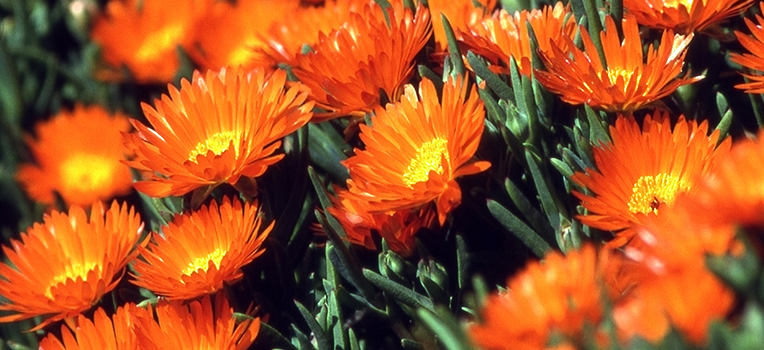Ground Covers
There’s very little soil to be seen in my garden. Ground cover plants fill in between the shrubs and trees and conceal it. Is that a good thing you ask? The answer is yes! Protecting soil with living green plants keeps weeds at bay, retains soil moisture and shades the soil surface in summer. It is a long-term alternative to mulch.
Ground cover plants also solve planting problems. They are the solution for areas where it is hard to get taller plants to grow, such as where there’s a prevailing wind, salt spray or dry soil. Top choices for these situations are plants that naturally grow on sand dunes such as native pigface (Carpobrotus ‘Aussie Rambler’), golden guinea vine (Hibbertia scandens) and creeping boobiala (Myoporum parvifolia).
As well, to my eye at least, a garden where the soil is concealed is more aesthetically pleasing than one where plants are surrounded by bare earth, or where there’s masses of hard paving.
As well as concealing soil, ground cover plants soften the look of paving and fill spaces between stepping-stones. Low-growing herbs such as creeping thyme or pennyroyal grow well among pavers. So do low-growing, silver-leafed plants such as dianthus (carnations or pinks), snow-in-summer (Cerastium tomentosum), or lambs tongue (Stachys lanata). For a dramatic designer look, plant dark green mini mondo grass between paving squares.
For full-sun areas, mixed succulents make a dense and vibrant ground cover planting.
Double duty
Some ‘climbers’, double as ground covers. A good example is star jasmine (Trachelospermum jasminoides). While this plant is happy to climb up a wall, it can grow across the ground or down a slope. Variegated star jasmine (T. jasminoides ‘Tricolor’) is a pretty option with year-round colour from its variegated white, pink and green foliage.
Other climbing or trailing plants include nasturtium, happy wanderer (Hardenbergia violacea) or a ground cover rose such as Flower Carpet.
While it is important that a ground cover forms roots or produces dense growth as it spreads, be wary of overly vigorous growers that become invasive. Ivy for example is an excellent ground cover plant. It’s leafy all year round, is drought and shade tolerant, but also has a tendency to scale walls, trees and everything in its path, which makes it high maintenance. Better-behaved options are lamium, ajuga or, for a very sunny spot, Spanish shawl (Heterocentron elegans). If the area is shaded select Australian native violet, baby’s tears or plectranthus.
Taller choices
Where it isn’t going to be walked on, a ground cover plant doesn’t have to be completely flat. Oyster plant (Acanthus mollis) is a tall leafy ground cover, which does particularly well covering soil in dry, shaded situations. Agapanthus and clivia with their strappy green leaves, also make good ground cover plants.
Many native plants make excellent tall ground cover plants including prostate grevilleas (such as ‘Poorinda Royal Mantle’), prostrate wattles and even prostrate forms of she oak.
Planting tip: Cover the soil around newly planted ground cover plants with mulch to prevent weeds from growing while the plants expand to cover the area.
Pictured: Pigface Mesembrayanthemum

